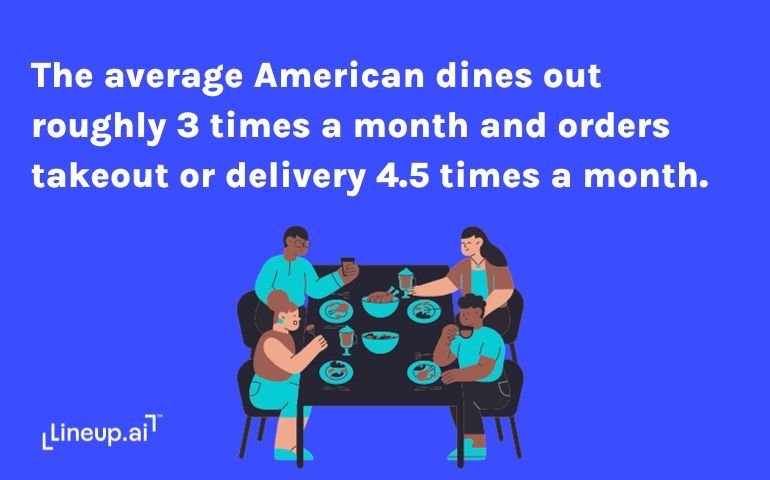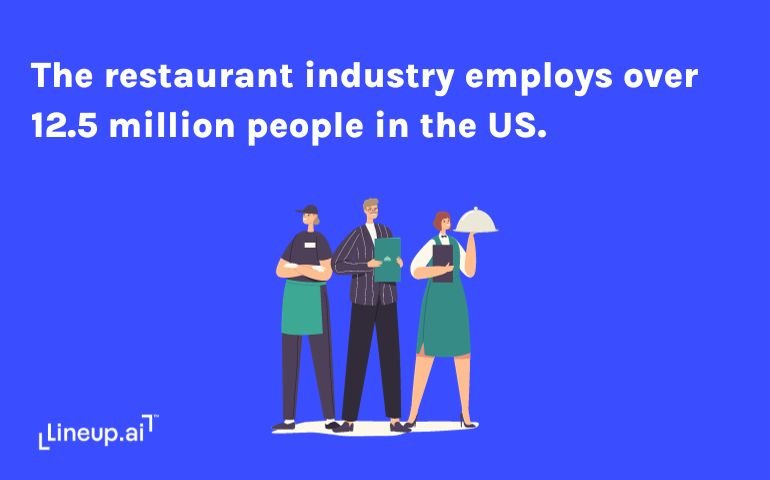The restaurant industry stands as a cultural cornerstone and economic powerhouse, shaping the way people dine and contributing significantly to the global economy. As we step into 2024, let's explore key restaurant industry statistics, from its overall size and economic impact to service metrics, costs, profits, staffing, and the ever-evolving role of technology.
General Restaurant Industry Stats
From one-off locations to chain restaurants, pre-pandemic to post-pandemic, and the ever-changing behavior of restaurant consumers, there are so many different stats to break down. Let's start with some of the more general stuff.

How popular is the restaurant industry?
It’s probably not surprising that Americans love restaurants. The restaurant industry can be tough to stay profitable in, but restaurants and bars are still major social hubs. The rise in food delivery apps has also caused an increase in takeout and delivery. According to US Foods, the average American dines out roughly 3 times a month and orders takeout or delivery 4.5 times a month! Gen Z’s appreciation for restaurants is growing, with 10% of their demographic dining out at least once a week.
What percentage of the US economy is the restaurant industry?
Despite taking a slight hit during the pandemic, restaurants contribute around 3-4% to the United States GDP, reflecting their substantial economic influence.
How big is the US restaurant industry?
The US restaurant industry boasts an impressive annual revenue, hitting $975.92 billion in 2022, emphasizing its massive scale. 2023 showed consistent growth, especially towards the end as inflation slowed down. According to the National Restaurant Association, restaurant industry revenue grew 8.5% from February to November.
How many restaurants are there in the US?
As of 2023, there are approximately 749,404 restaurants in the United States. This figure represents a diverse range of dining establishments, from fast-food chains to fine dining restaurants.
What is the restaurant market share in the US?
According to IBISworld and Statista, as of 2022, there were:
- Just under 200,000 quick service restaurants (QSR) in the US
- 4,300 fine-dining restaurants in the US
- 38,411 coffee shops in the US
- 9,709 breweries in the US
Amidst this diverse landscape, the total number of restaurant locations in the US exceeds 1 million, employing over 15.6 million workers. This significant employment figure underscores the restaurant industry's critical role as a major employer and its contribution to the US economy.
What is the biggest restaurant chain in US?
The largest restaurant chain in the United States is Subway, in terms of the number of locations.
What is the #1 fast food chain in the US?
McDonald's is the #1 fast food chain in the United States in terms of sales revenue.
What food sells the most in restaurants?
As of Q3 of 2023, the most popular food items in US restaurants were:
- French fries
- Hamburgers
- Mashed potatoes
- Grilled cheese
- Steak
What is the most profitable restaurant type?
The most profitable types of restaurants in 2023 were:
- Quick-service
- Fine-dining
- Food trucks
- Buffets
- Seafood restaurants
What is the fastest-growing segment in the restaurant industry today?
Ghost kitchens and virtual restaurants are the fastest-growing segments, with a staggering 85% growth rate in the past year. They’re expected to become a $71.4 billion industry by 2027.
What is the restaurant failure rate?
According to statistics, there is an estimated 80% failure rate for restaurants in their first year and 60% within the first year of operation.
What is the average lifespan of a restaurant?
The average lifespan of a restaurant can vary significantly based on location, type of cuisine, management, economic conditions, and competition, among other factors. However, a commonly cited statistic is that the average life of a restaurant is only 8 - 10 years.
What is the average waste percentage in restaurants?
A study focusing on minimizing food waste has shown that restaurants end up wasting about 4% to 10% of the food they purchase, and between 30% to 40% of the food served to customers goes uneaten.
Restaurant Service Stats
It seems like the foodservice industry has largely returned to normal since the pandemic. The online ordering market is still prominent and expected to grow to $505.5 billion by 2030, while fast casual and full-service restaurants have seen a nice rebound according to various industry reports. Restaurant owners can start to focus more on service levels than trying to offset the dip in annual sales caused by the pandemic.

Average restaurant wait time
- The average wait time is between 15 and 30 minutes
- The average service time varies between 30 to 40 minutes
Average number of customers in a restaurant per day
On average, a typical restaurant accommodates about 100-200 customers daily.
Average restaurant seating capacity
- The average seating capacity is 75, with popular restaurants accommodating up to 150 patrons at peak times
Restaurant Ordering Statistics
- The food delivery services segment is expected to reach $125 billion by 2028
- 51% of customers prefer food ordering directly from a restaurant’s website instead of a third-party app
Restaurant industry labor statistics
- The restaurant industry employs over 12.5 million people in the US
- The restaurant industry employs a higher percentage of minority managers than any other industry.
- The average age of a restaurant worker is 29 years old, reflecting a dynamic and youthful workforce
The restaurant industry continues to be a significant employer, providing over 15 million jobs and comprising over 10% of the US workforce.
- 63% of US adults have worked in the restaurant industry
- 90% of restaurant managers started as entry-level employees
- 90% of restaurants have fewer than 50 team members
The average turnover rate in restaurants
- The turnover rate in the restaurant industry is 75%
- Turnover among front-of-house employees can cost a restaurant nearly $6,000 per person
Restaurant Industry Sales Stats
No list of restaurant statistics is complete without sales stats. Maintaining profitability starts with sales and remains one of the top challenges for restaurant owners today. Restaurant revenue can be elusive, but numbers over the last several quarters have been strong and encouraging.

What is the average sales for a restaurant?
- The average restaurant sales per day in the US is $1350
- New restaurants average $111,861 per month in the first year
What percentage of restaurant sales are cash?
- Just 19% of dine-in patrons pay in cash
- Fast-food restaurants saw the highest amount of cash payments at 39%
Restaurant Cost Stats
It’s no secret that operating a restaurant is expensive. While 2023 saw a lot of changes in inflation that were occasionally passed off to U.S. consumers, restaurateurs were tasked with balancing costs across the board.
Average restaurant operating costs
Restaurant operating costs average around 30% of total revenue, covering various expenses like rent, utilities, and maintenance.
Average restaurant expenses per month
Monthly expenses for restaurants typically range from $30,000 to $50,000, representing 25% to 35% of overall revenue.
Average restaurant labor cost percentage
Labor costs account for approximately 30% of total expenses, showcasing the labor-intensive nature of the industry.
How much does a restaurant spend on food and liquor per month?
- Food costs represent 28% to 35% of total expenses
- Restaurants experience an average food waste of 4% to 10%
- Liquor costs for restaurants typically range from 18% to 24% of total beverage revenue
Average restaurant startup cost
- According to Toast, starting a new restaurant requires an average investment of $95,000 to over $2 million, depending on the concept and location
- Buyers can expect to pay an average of $178 per square foot while those who lease can expect to pay around $159 per square foot
Restaurant Profitability Stats
Strong sales don’t always indicate higher profit margins, especially with labor costs and supply costs rising. Fortunately, profit margins remained fairly consistent across the restaurant industry.
- The average restaurant profit margin ranges from 3% to 5%, emphasizing the thin margins within the industry.
- Fine dining establishments maintain a profit margin of 8% to 12%, given their upscale nature
- Fast food restaurants typically operate with a profit margin of 5% to 8%, balancing lower prices with high volume
Restaurant Technology Stats
The role of technology in restaurant operations continues to grow significantly. Given the commonly reported pain points like higher labor costs, higher food costs, and labor shortages, many of the most popular technologies included things like labor management, forecasting, scheduling, and inventory management.
- 97% of restaurants use online food delivery platforms
- Restaurants use an average of 3 different technologies to support operations
- Over 40% of restaurants are now using TikTok as part of their marketing strategies
- 41% of restaurants use tablets connecting to a POS system instead of pen and paper
Final Thoughts
The restaurant industry in 2024 is huge and still growing in some interesting areas. Each year, new trends emerge that shape the way people dine from carryout at ghost kitchens to Michelin-starred experiences. From the economic impact of restaurants to service metrics, costs, profits, staffing, and the integration of technology, these restaurant industry statistics provide a comprehensive snapshot of the state of the restaurant industry over the last few years and heading into the future. Stay tuned for updates as the industry continues to evolve and adapt to changing consumer preferences and technological advancements.

The team at Lineup.ai is composed of seasoned professionals who hold deep insights into the unique challenges and pain points of the restaurant industry, and are equally skilled in artificial intelligence, machine learning, and data analytics. This fusion of expertise enables Lineup.ai to create cutting-edge AI solutions specifically tailored for the restaurant sector. The technical and analytical prowess of the team, combined with a deep understanding of the unique challenges faced by restaurants, forms the cornerstone of the company's innovation. The team at Lineup.ai also excels in communicating the benefits and applications of AI and machine learning to businesses, ensuring clients fully leverage the capabilities of these solutions.
More about the author